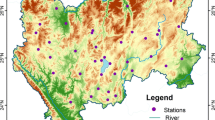Abstract
The correlation between mean surface air temperature and altitude is analyzed in this paper based on the annual and monthly mean surface air temperature data from 106 weather stations over the period 1961–2003 across the Qinghai-Tibet Plateau. The results show that temperature variations not only depend on altitude but also latitude, and there is a gradual decrease in temperature with the increasing altitude and latitude. The overall trend for the vertical temperature lapse rate for the whole plateau is approximately linear. Three methods, namely multivariate composite analysis, simple correlation and traditional stepwise regression, were applied to analyze these three correlations. The results assessed with the first method are well matched to those with the latter two methods. The apparent mean annual near-surface lapse rate is −4.8 °C /km and the latitudinal effect is −0.87 °C /olatitude. In summer, the altitude influences the temperature variations more significantly with a July lapse rate of -4.3°C /km and the effect of latitude is only −0.28°C /olatitude. In winter, the reverse happens. The temperature decrease is mainly due to the increase in latitude. The mean January lapse rate is −5.0°C /km, while the effect of latitude is −1.51°C /olatitude. Comparative analysis for pairs of adjacent stations shows that at a small spatial scale the difference in altitude is the dominant factor affecting differences in mean annual near-surface air temperature, aided to some extent by differences of latitude. In contrast, the lapse rate in a small area is greater than the overall mean value for the Qinghai-Tibet Plateau (5 to 13°C /km). An increasing trend has been detected for the surface lapse rate with increases in altitude. The temperature difference has obvious seasonal variations, and the trends for the southern group of stations (south of 33° latitude) and for the more northerly group are opposite, mainly because of the differences in seasonal variation at low altitudes. For yearly changes, the temperature for high-altitude stations occurs earlier clearly. Temperature datasets at high altitude stations are well-correlated, and those in Nanjing were lagged for 1 year but less for contemporaneous correlations. The slope of linear trendline of temperature change for available years is clearly related to altitude, and the amplitude of temperature variation is enlarged by high altitude. The change effect in near-surface lapse rate at the varying altitude is approximately 1.0°C /km on the rate of warming over a hundred-year period.
Similar content being viewed by others
References
China Meteorological Administration (2003) The ground meteorological observation criterion, Beijing, China. Meteorology Press. pp 35–47. (In Chinese)
Fu BP (1983) Mountain climate, Beijing, China. Science Press. pp 114–122. (In Chinese)
Fu BP, Yu JM, Lu QY (1996) Climatic resources and their exploitation and utilization in mountains, Nanjing, China. Nanjing University Press. pp 132–145. (In Chinese)
Huang ZY (1994) Mountain climate features of northeast Yunnan. Mountain Research 12(1): 32–38.
Lin ZG (1984) The research on main factors affecting temperature lapse rate and its annual variation in mountains, China. Conference Proceedings for Mountain Climate. China Meteorological Press.
Li X, Cheng GD, Lu L (2003) Comparison study of spatial interpolation methods of air temperature over Qinghai-Xizang Plateau. Plateau Meteorology 22(6): 565–572.
Li SC, Xu L, Guo YX, etal (2006) Change of annual air temperature over Qinghai-Tibet Plateau during recent 34 years. Journal of Desert Research 26(1): 27–34.
Li QY, Xie ZC (2006) Analyses on the characteristics of the vertical lapse rates of temperature-taking Tibetan Plateau and its adjacent area as an Example. Journal of Shihezi University (Natural Science) 24(6): 719–723.
Liu XD, Hou P (1998) Relationship between the climatic warming over the Qinghai-Xizang Plateau and its surrounding areas inrecent 30 years and the elevation. Plateau Meteorology 17(3): 245–249.
Masatoshi M. Yoshino (1975) Climate in a small area. University of Tokyo Press. pp 189–195.
Pan BT, Li JJ, Zhu JJ etal (1995) Qinghai-Tibetan Plateau: A driver and amplifier of the global climatic change. Journal of Lanzhou University (Natural Sciences) 31(4): 160–167.
Roger G.B (1981) Mountain weather and climate, Methuen, London and New York. pp 39–50.
Tang MC, Li CQ, Zhang J (1988) Recent climate change over Qinghai-Tibet Plateau and surrounding. Plateau Meteorology 7(1): 40–48.
Wen DM, Sun ZA (1984) Preliminary study on temperature lapse rate in mountains in China. Geographical Research 3(2): 24–34.
Wen DM, Luo ZX (1990) Topoclimate for mountains. Beijing, China. China Meteorological Press. pp 144–154. (In Chinese)
Xu JH (2002) Mathematical methods in contemporary geography. Beijing, China. Higher Education Press. pp 37–47.
Zhou SZ et al (1982) Meteorology and climatology. Beijing, China. Peoples Education Press. pp 211–212. (In Chinese)
Author information
Authors and Affiliations
Corresponding author
Rights and permissions
About this article
Cite this article
Wang, K., Sun, J., Cheng, G. et al. Effect of altitude and latitude on surface air temperature across the Qinghai-Tibet Plateau. J. Mt. Sci. 8, 808–816 (2011). https://doi.org/10.1007/s11629-011-1090-2
Received:
Accepted:
Published:
Issue Date:
DOI: https://doi.org/10.1007/s11629-011-1090-2




